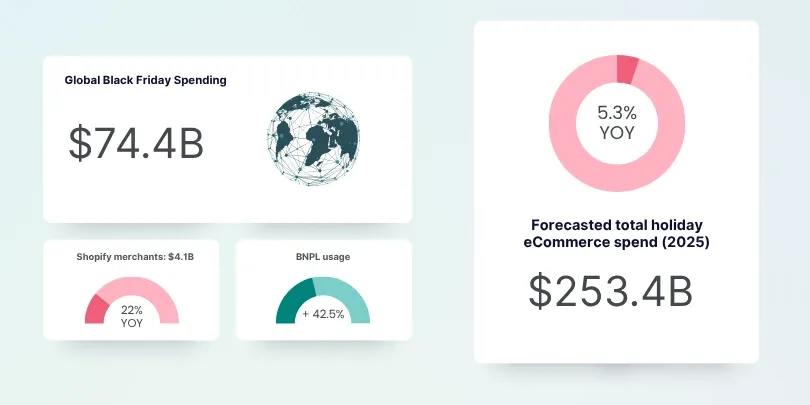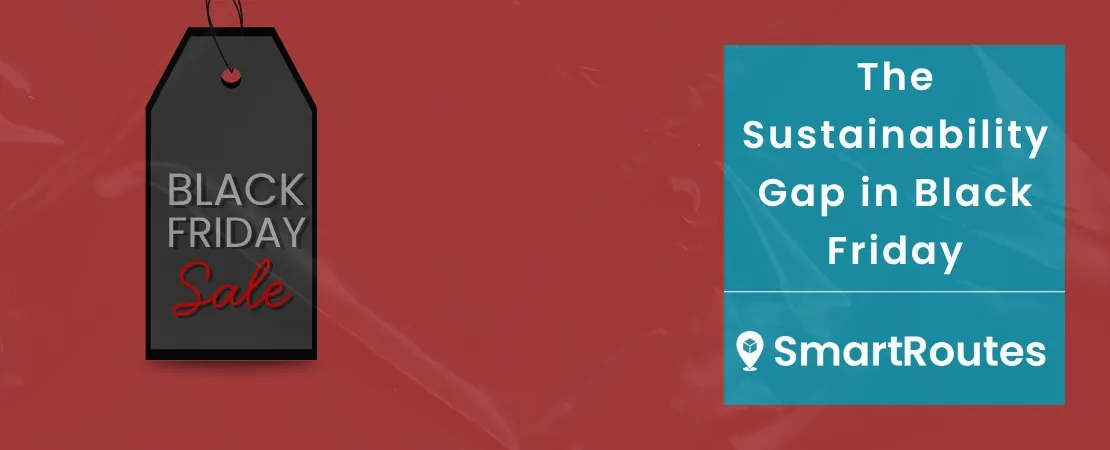Quick Summary
- Black Friday online sales are expected to exceed $10.8B in the U.S. alone, generating an estimated 3.6M tonnes of CO₂ from delivery emissions.
- Retail giants like IKEA, Amazon, and Currys have pledged to electrify delivery fleets but charging infrastructure, vehicle availability, and range limits are slowing progress.
- Consumer demand for eco-friendly delivery is rising, with 51% choosing greener options when available.
- Smaller retailers now contribute equally to peak delivery volumes, driven by platforms like TikTok Shop and Shopify.
- Delivery optimization could remove emissions equivalent to 300,000+ cars, without waiting for electric vehicle adoption.
Black Friday 2025 is expected to once again break eCommerce records, with U.S. online sales alone projected at over $10.8 billion [1].
Leading retailers have made bold climate pledges: IKEA aims for 90% electric deliveries by 2028, Currys' plans to electrify half its fleet by 2030, and Amazon, H&M, and Target have all committed to net zero by 2040 [2][3][4][5][6]. Apple targets carbon neutrality by 2030, and Tesco by 2050 [7][8].
While these pledges are commendable, there is a clear opportunity to reduce emissions immediately: optimizing the delivery process.
SmartRoutes data shows that even just route optimization can deliver 15–20% fewer miles driven and 20–25% more deliveries per vehicle [15], creating immediate carbon reductions without waiting for fleet electrification.
Methodology
- Parcel estimates: Based on Black Friday online sales divided by the European average order value (€277) [9].
- Emissions per parcel: Set at 100g CO₂ [10].
- Optimization savings: Based on SmartRoutes delivery data (15–20% fewer miles, 20–25% more deliveries per vehicle).
- Car equivalents: Calculated using average passenger vehicle emissions of 2.75 tonnes CO₂ annually [11].
This methodology produces a standardized view of Black Friday’s delivery emissions footprint across 2 key markets.
Estimated Black Friday Delivery Emissions by the US & UK
| Country | Est. Online Sales | Est. Parcels | Emissions | Potential Savings | Equiv. Cars Off the Road |
|---|---|---|---|---|---|
| United States | $10.8B (~€9.9B) [1] | ~36M | ~3.6M tonnes CO₂ | 0.72–0.9M tonnes | 260,000–330,000 |
| United Kingdom | £3.6B (~€4.1B) [12] | ~15M | ~1.5M tonnes CO₂ | 0.3–0.375M tonnes | 110,000–135,000 |
Key finding: Black Friday deliveries in the U.S. alone create over 3.5 million tonnes of CO₂ in a single weekend. Optimized routing could remove the equivalent emissions of over 300,000 cars.
Retailers’ Climate Pledges: Long-Term Goals vs Immediate Impact
| Retailer | Net-Zero Target | Sustainability Strategy |
|---|---|---|
| IKEA | 2050 | 90% EV deliveries by 2028 [2] |
| Currys | 2040 | 50% medium/heavy fleet electric by 2030 [3] |
| H&M | 2040 | EV/alternative fuels [5] |
| Amazon | 2040 | Climate Pledge co-founder [4] |
| Apple | 2030 | Lower-carbon transport prioritized [7] |
| Tesco | 2050 | Supply chain net zero [8] |
| Target | 2040 | 100% renewable electricity by 2030 [6] |
Observation: While electrification targets are crucial, operational efficiency in delivery logistics would yield substantial carbon savings today without waiting for EV adoption to scale.
The Challenges of Switching to Electric Vehicles
While electrification targets are an important part of long-term sustainability strategies, retailers face several practical challenges when adopting EVs today:
- Vehicle availability: The COVID-19 pandemic disrupted EV manufacturing and supply chains, limiting the number of vehicles available for delivery fleets.
- Charging infrastructure: Many regions still lack sufficient charging points, which can make fleet deployment and scheduling difficult.
- Range limitations: EVs have a finite distance per charge, which can constrain delivery routes and require careful planning to avoid inefficiencies.
- Battery degradation: Over time, EV batteries lose efficiency, which can reduce range and require replacement, adding to operational costs.
- Seasonal and weather impacts: Cold or hot weather can reduce battery performance, affecting range and delivery reliability.
These challenges are compounded by the environmental cost of EV production.
Battery electric vehicles (BEVs) have approximately 40% higher production emissions than conventional internal combustion engine vehicles (ICEVs) due to the battery manufacturing process [13]. On average, it takes around 17,000 km of driving (typically within the first one or two years) to offset these higher production emissions [13]. However, over their full lifecycle, BEVs still produce about 24% less CO₂ than ICEVs.
Unlike switching to electric vehicles, optimizing delivery routes has no negative environmental trade-offs, meaning retailers can achieve immediate, measurable emissions reductions today.
Consumers & Market Context
- Younger shoppers are factoring sustainability into Black Friday purchase decisions [14].
- Black Friday adds 1.2 million tonnes of CO₂ from trucks across Europe in a single week, a 94% spike compared to average weeks [16].
- In 2024, 51% of shoppers chose eco-friendly delivery options when given the choice [17].
Consumers clearly want greener delivery options, but without optimizing delivery processes, retailers cannot fully deliver on this expectation.
Black Friday’s Hidden Costs: Why Smarter Delivery Matters
| Metric | Value |
| TikTok Shop sales on Black Friday 2024 | $100M, 165% YoY growth (BF–CM) [18] |
| Global Black Friday spending | $74.4B [19] |
| Holiday eCommerce return rates | 30% [20] |
| Buy Now, Pay Later (BNPL) usage | +42.5% YoY [21] |
| Shopify merchants' Black Friday sales | $4.1B, 22% YoY increase, $4.6M processed per minute [22] |
| European peak order rate | 11.4 orders/sec, 205% spike vs normal periods [23] |
| Late deliveries | +70% vs regular weeks, avg delivery promise up to 6 days [23] |
| Forecasted total holiday eCommerce spend (Nov 1–Dec 31, 2025) | $253.4B (+5.3% YoY) [24] |
| % of global shoppers making a purchase BF & CM | 75% [25] |
| UK Black Friday delivery emissions | 429,000 metric tons CO₂ (~435 London–NY flights) [26] |
| Online shopping vs in-store emissions | Online can be higher due to warehouse energy & home delivery [27] |
| Item & packaging waste | Up to 80% of items discarded after minimal use [27] |
- Black Friday is no longer just a shopping event, it’s a logistics and environmental challenge, with millions of orders creating significant CO₂ emissions.
- Smaller retailers are now generating high order volumes alongside giants, as indicated by Shopify and TikTok stats. This demonstrates that delivery optimization is relevant to all businesses, not just the major brands profiled.
- Increasing use of Buy Now, Pay Later (BNPL) and other incentives suggests Black Friday will continue growing each year, amplifying delivery-related emissions.
- High rates of returns and late deliveries further increase emissions, making efficient route planning a tangible, immediate solution.
- The combination of these trends shows that addressing delivery logistics now can significantly reduce environmental impact, even before retailers reach their long-term net-zero targets.

Missed Deliveries = Extra Emissions
Late or missed deliveries are common during Black Friday peaks. Each failed delivery often results in a repeat trip, effectively doubling emissions for affected parcels.
Retailers can mitigate this in several ways:
- Offer time windows that align with customer availability, reducing the likelihood of failed attempts.
- Send delivery notifications and real-time tracking updates so customers can plan to be home or redirect parcels if needed.
- Use live tracking tools to allow customers to follow drivers in real time, preventing wasted trips.
- Apply route optimization and intelligent dispatching to reduce unnecessary mileage and ensure drivers are covering the most efficient routes.
- Collect electronic proof of delivery (ePODs) to eliminate paper and provide instant confirmation, avoiding disputes and returns.
Why Retailers Overlook Delivery
It’s understandable why delivery optimization rarely features in sustainability pledges. Packaging is visible to consumers. Product materials are tangible. Donation programs generate positive press.
Delivery, by contrast, happens behind the scenes and is often managed by third-party logistics providers.
Yet the emissions are just as real, and in many cases, easier to reduce than other parts of the supply chain. Unlike redesigning products or sourcing new sustainable materials, route optimization technology exists today and can deliver immediate results.
Recommendations for Retailers
SmartRoutes data shows that optimizing delivery routes can remove hundreds of thousands of tonnes of CO₂ in one weekend alone.
Retailers already taking steps on sustainability, such as IKEA’s circular economy commitments or Currys’ energy efficiency initiatives, can amplify their impact immediately by optimizing delivery logistics.
1. Plan Deliveries to Reduce Total Miles Driven
Group deliveries geographically to prevent multiple vans from revisiting the same area on the same day.
Better delivery planning helps maximize vehicle capacity, minimize wasted trips, and reduce overall fuel use. Over time, this translates to lower costs per delivery and fewer emissions per parcel.
2. Offer Flexible or Eco Delivery Options
Customers increasingly value sustainability.
Retailers can offer eco-delivery options where orders are grouped by area and dispatched once a threshold volume is reached.
When framed as a sustainable choice, most consumers are willing to wait slightly longer to reduce unnecessary delivery trips and emissions.
3. Improve First-Time Delivery Success
Late or missed deliveries add unnecessary emissions and costs.
Retailers can avoid repeat trips by offering time-window booking, sending delivery notifications, and enabling live tracking.
Customers who know when to expect a delivery are far more likely to be available, reducing failed attempts and extra van mileage.

4. Digitize Proof of Delivery
Replacing paper delivery notes with electronic proof of delivery (ePOD) cuts paper waste and improves accountability.
Digital records also help track delivery success rates and identify efficiency gaps across the fleet.
5. Audit Delivery Partners on Route Efficiency, Not Just Speed
Retailers working with couriers or 3PLs should evaluate them on route efficiency, consolidation rates, and emissions per parcel, not just speed.
By reviewing historical routing performance and encouraging the use of optimization software, retailers can extend their sustainability standards beyond their own operations.
6. Use Optimization Technology as the Enabler
Route optimization software should be viewed as the enabler, not the sole solution.
When paired with improved communication, better customer coordination, and flexible scheduling, technology delivers compounding benefits: fewer miles, fuller vans, and measurable carbon reductions.
7. Use Micro-Fulfillment Centers or Local Depots
Positioning smaller fulfillment hubs closer to major customer clusters shortens delivery distances, especially during Black Friday and other peak periods.
This approach reduces last-mile emissions and speeds up delivery times without adding more long-haul trips.
8. Promote in-store Pickup for Local Customers
Encouraging nearby shoppers to collect orders in-store can ease pressure on delivery networks and eliminate short-distance emissions altogether.
Clear communication at checkout about carbon savings can help customers make that choice confidently.
Why this matters: For retailers operating their own fleets, these measures deliver rapid ROI through fuel savings and operational efficiency. For those relying on third-party providers, applying these practices ensures that sustainability pledges translate into measurable emissions reductions today, rather than waiting for fleet electrification goals years in the future.
The Opportunity Ahead
Retailers do not need to abandon existing sustainability initiatives; recycling programs, sustainable materials, and charitable giving remain essential. However, delivery represents one of the largest controllable sources of emissions, and Black Friday highlights just how significant this can be.
SmartRoutes recommends that retailers adopt tangible measures to optimize their delivery operations. By reducing miles driven, increasing deliveries per vehicle, and improving route efficiency, businesses can achieve immediate emissions reductions while maintaining or improving service levels.
These actions provide a clear business case, with ROI often realized within months, and complement long-term electrification or net-zero strategies.
Black Friday 2025 is more than just a peak shopping period, it is an opportunity for retailers to expand their sustainability commitments to include the final mile, turning pledges into measurable impact.
The question remains: will the industry seize this opportunity, or will delivery continue to be the overlooked piece of the sustainability puzzle?
References
[1] DigitalCommerce360 Black Friday 2024 ecommerce sales
https://www.digitalcommerce360.com/article/black-friday-ecommerce-sales/
[2] IKEA Zero Emissions for Home Deliveries
https://www.ikea.com/global/en/our-business/sustainability/zero-emissions-for-home-deliveries/
[3] Currys Climate Action Strategy
https://www.currysplc.com/sustainable-business/climate-action/
[4] Amazon Climate Pledge
https://www.aboutamazon.eu/planet
[5] Patagonia & H&M Net Zero Pledges
https://www.reccessary.com/en/news/inside-h-m-patagonia-climate-moves
[6] Target Sustainability Strategy
https://corporate.target.com/sustainability-governance/strategy-target-forward
[7] Apples Environment Progress Report
https://www.apple.com/ie/environment/
[8] Tesco's Target Sustainability Reports
https://www.tescoplc.com/media/wvkj1yic/tesco-sustainability-report-2025.pdf
[9] PwC's Black Friday & Cyber Monday Survey Europe
https://www.pwc.ie/media-centre/press-releases/2024/black-friday-survey.html
[10] Supply Chain Movement Emissions per parcel
https://www.supplychainmovement.com/co2-emissions-per-parcel-down-56-over-last-five-years/
[11] Cars Ireland Average car emits 2.75 tonnes CO2 annually
https://www.carsireland.ie/reviews/facing-reality-our-cars-emitting-275-tonnes-co2-every-year
[12] Adobe UK Black Friday spend
https://business.adobe.com/blog/uk-consumers-spent-25-billion-during-2024-holiday-season
[13] Life-cycle greenhouse gas emissions from passenger cars in the European Union A 2025 update and key factors to consider
https://theicct.org/publication/electric-cars-life-cycle-analysis-emissions-europe-jul25/
[14] PwC's Black Friday & Cyber Monday Ireland Survey
https://www.pwc.ie/publications/2024/black-friday-cyber-monday-survey.pdf
[15] SmartRoutes Data Internal platform benchmarks
[16] Transport & Environment Black Friday trucking impact
https://www.transportenvironment.org/articles/black-friday-exposes-dark-side-of-trucking
[17] Ingrid Black Week 2024 delivery insights
https://www.ingrid.com/blog/black-friday-insights-2024
[18] Retail Dive TikTok Shop sales Black Friday 2024
https://www.retaildive.com/news/tiktok-shop-sales-surpass-100m-black-friday/735208/
[19] Salesforce Global Black Friday spending record
https://www.salesforce.com/news/press-releases/2024/12/04/cyber-week-ai-sales/
[20] Return Pro Holiday eCommerce return rates
[21] Adobe Analytics BNPL growth
https://business.adobe.com/blog/the-latest/buy-now-pay-later-giving-shoppers-more-choice-at-checkout
[22] Shopify Black Friday merchant sales
[23] Ingrid Black Friday insights Europe 2024
https://www.ingrid.com/blog/black-friday-insights-2024
[24] Adobe Holiday Shopping Report 2025 forecast
https://business.adobe.com/resources/holiday-shopping-report.html
[25] DHL 2025 Black Friday trends
[26] Clean Hub UK Black Friday delivery emissions
https://www.cleanhub.com/blog/black-friday-environmental-impact


